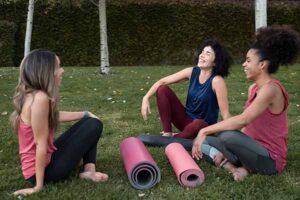Mindful Movement: Therapy and Fitness Together
Life can throw a lot at us, and finding ways to balance both our mental and physical health is key to getting through it. That’s where therapy and fitness come in. They may seem different at first, but together, they create a powerful combination that can help you feel more connected, balanced, and resilient.
What Is Mindful Movement?
Mindful movement is all about being present with your body as you move. It’s more than just exercising—it’s about tuning into how you feel physically and emotionally in the moment. Whether it’s through yoga, running, or dancing, the goal is to notice how your body feels and how you’re breathing, and to stay present with yourself throughout the movement.
When you combine mindful movement with therapy, it becomes a way to support both your mental and physical well-being.
Therapy: Giving Your Mind What It Needs
Therapy is where you can sort through your thoughts, explore your feelings, and figure out how to cope with everything life throws your way. It’s a place to work through deep emotional stuff, like past trauma, anxiety, or stress. Therapy teaches you tools for emotional regulation and helps you gain the perspective needed to approach life’s challenges with a clearer mind.
The more you understand your emotions in therapy, the easier it becomes to handle tough situations. And when you add mindful movement to the mix, you’re giving your body and mind a way to work together—so the changes you’re making in your mind can also be reflected in your physical well-being.
Fitness: More Than Just a Workout 
Exercise isn’t just about getting in shape; it’s also about feeling good mentally. Moving your body releases endorphins, those “feel-good” chemicals that help reduce stress and lift your mood. It’s why a brisk walk, a run, or a good yoga session can instantly change how you feel.
When you do fitness mindfully, you bring your focus to your body and breath. Whether it’s stretching, walking, or doing a high-intensity workout, being aware of your movements in real-time allows you to let go of the day’s stress and tune into how your body is reacting. Fitness becomes a way to ground yourself and release tension, helping you feel more connected and centered.
How Therapy and Fitness Work Hand-in-Hand
Both therapy and fitness have their own unique benefits, but when you bring them together, you get something even more powerful. Here’s how they complement each other:
- Self-Awareness and Focus: Therapy helps you dive into your emotions, while fitness trains you to stay focused and in the moment. Mindful movement brings awareness to how your body feels, while therapy helps you understand what’s going on emotionally. Combining the two gives you a deeper sense of self-awareness.
- Stress Relief: Therapy gives you the mental tools to manage stress, while fitness helps you release it physically. Whether it’s talking through a tough issue in therapy or working through it with movement, both help you feel less weighed down by life’s pressures.
- Building Resilience: Therapy strengthens your emotional resilience, and fitness helps you build physical resilience. Both teach you how to push through discomfort, whether it’s emotional or physical, and come out stronger on the other side.
- Improved Confidence: Therapy helps you address self-doubt and negative thoughts, while fitness shows you tangible results as you get stronger or more skilled. Both can help improve how you see yourself and increase your confidence, giving you a sense of accomplishment and self-worth.
Tips for Combining Therapy and Fitness
- Start Small: You don’t need to make big changes all at once. Whether it’s committing to a weekly therapy session or adding a short walk to your day, small steps can lead to big changes over time.
- Make It Mindful: As you work out, try to be aware of your breath and how your body feels. Instead of rushing through your workout, focus on moving with intention, and notice how your body responds.
- Create a Routine: Consistency is key. Make time for both therapy and fitness in your week. Whether it’s scheduling your therapy appointments or setting aside time for movement, having a routine helps keep you on track.
- Reflect on Your Journey: After a therapy session or a workout, take a moment to reflect. How are you feeling? What did you learn about yourself? This reflection helps reinforce your growth and keeps you motivated.
- Be Kind to Yourself: Building mental and physical strength is a journey, and it’s okay not to be perfect. Therapy and fitness are both processes, and every step forward—no matter how small—is progress.
Conclusion
Therapy and fitness may seem like separate things, but when combined, they create a holistic approach to well-being that helps you feel stronger, both mentally and physically. Therapy supports your emotional health by helping you work through issues, while fitness gives your body a way to release tension, boost your mood, and build resilience.